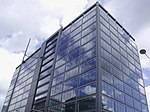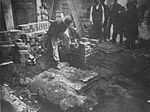Post and Mail building, Birmingham
Buildings and structures completed in 1964Buildings and structures demolished in 2005Buildings and structures in Birmingham, West MidlandsDemolished buildings and structures in the West Midlands (county)Former skyscrapers ... and 3 more
John MadinModernist architecture in EnglandNewspaper headquarters in the United Kingdom

The Birmingham Post and Mail building was constructed in the 1960s and was a symbol of the rebuilding of Birmingham, England, following the devastation of World War II.
Excerpt from the Wikipedia article Post and Mail building, Birmingham (License: CC BY-SA 3.0, Authors, Images).Post and Mail building, Birmingham
Colmore Circus Queensway, Birmingham Digbeth
Geographical coordinates (GPS) Address Nearby Places Show on map
Geographical coordinates (GPS)
| Latitude | Longitude |
|---|---|
| N 52.483769444444 ° | E -1.8961222222222 ° |
Address
Colmore Plaza
Colmore Circus Queensway 20
B4 6AT Birmingham, Digbeth
England, United Kingdom
Open on Google Maps









